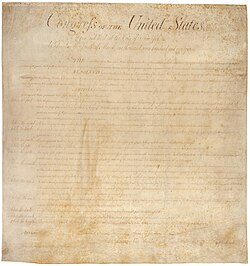Third Amendment to the United States Constitution
| This article is part of a series on the |
| Constitution of the United States of America |
|---|
 |
| Preamble and Articles of the Constitution |
| Amendments to the Constitution |
|
|
| Proposed Amendments |
| History |
| Full text of the Constitution and Amendments |

The Third Amendment (Amendment III) to the United States Constitution places restrictions on the quartering of soldiers in private homes without the owner's consent. It forbids the practice completely during peacetime. The amendment is a response to the Quartering Acts passed by the British parliament between the French and Indian War and the American Revolutionary War. They allowed the British Army to house soldiers in private homes in the American colonies.
The Third Amendment was introduced in Congress in 1789 by James Madison. It was a part of the United States Bill of Rights in response to Anti-Federalist objections to the new Constitution. Congress proposed the amendment to the states on September 28, 1789. By December 15, 1791, the necessary three-quarters of the states had ratified it. Secretary of State Thomas Jefferson announced the adoption of the amendment on March 1, 1792.
The amendment is one of the least controversial of the Constitution and is rarely litigated. The American Bar Association called it the "runt piglet" of the U.S. Constitution.[1] There were times when the US government probably violated this amendment.[1] These include the War of 1812, the American Civil War, and during World War II in the Aleutian Islands.[1] But as of 2015 it has never been the primary basis of a Supreme Court decision.[2][3][4]
Third Amendment To The United States Constitution Media
James Madison, drafter of the Bill of Rights
Justice William O. Douglas
References
- ↑ 1.0 1.1 1.2 "How Did America's Police Become a Military Force On the Streets?". American Bar Association. 2013. Retrieved 27 January 2016.
- ↑ "The Third Amendment". Revolutionary War and Beyond. 7 September 2012. Archived from the original on 3 July 2014. Retrieved 27 January 2016.
- ↑ Mahoney, Dennis J. (1986). "Third Amendment". Encyclopedia of the American Constitution. Archived from the original on 6 November 2013. Retrieved 27 January 2016.
- ↑ "Third Amendment". U*X*L Encyclopedia of U.S. History. January 1, 2009. Archived from the original on 6 November 2013. Retrieved 27 January 2016.

